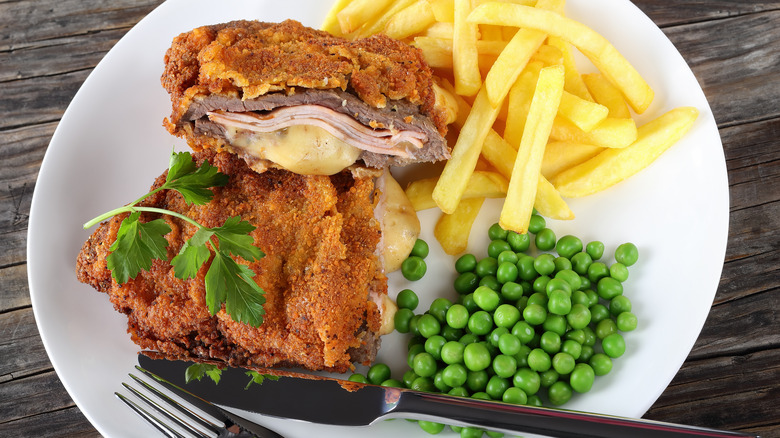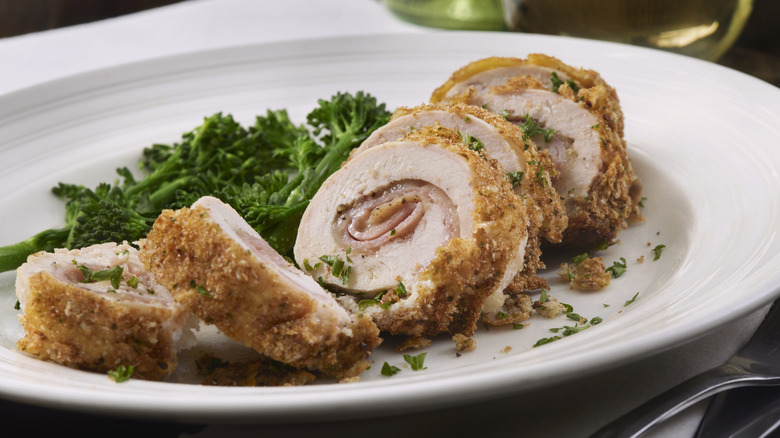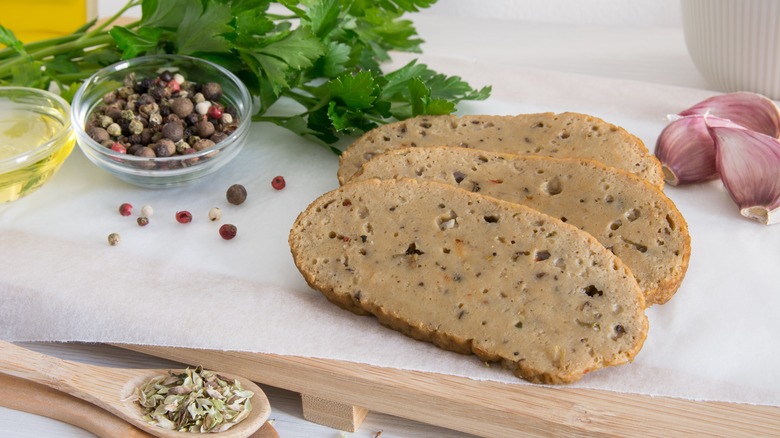You Should Be Giving Beef The Cordon Bleu Treatment
No, you shouldn't be giving your beef the "Le Cordon Bleu" treatment, which is the largest network of culinary schools in the world (although depending on how you interpret that, it probably wouldn't hurt). You should be giving your beef the "cordon bleu" treatment, a reference to the famous dish: chicken cordon bleu. If you've never had the pleasure of eating chicken cordon bleu, it's basically a piece of chicken that is stuffed with ham and cheese, rolled up, breaded, and fried resulting in a crispy hot pocket of protein and melty cheese.
The concept of a beef cordon bleu is effectively the same thing; subbing chicken breast for something like thinly sliced strip steak or veal. The beauty of using beef in this dish is it's very reminiscent of the classic American cheeseburger. You have the bread-like crust on the outside, beef as the primary protein, and lots of delicious melted cheese. In fact, while the original chicken recipe calls for ham, there's no reason why you couldn't use pieces of bacon in the inner layer instead. This would turn your beef cordon bleu into a self-contained bacon cheeseburger. The European originators of the dish might have scoffed at that idea, but that's okay. The great thing about the cordon bleu treatment is exploring what combinations work best with different proteins — in this case, beef.
The history of cordon bleu
Of course, there could be no beef cordon bleu without the creation of its poultry progenitor. Although its exact origins are not confirmed, the story goes that this dish was invented in a restaurant in Brigg, Switzerland, when the cook needed to improvise a new menu to stretch out the available ingredients to feed a larger-than-expected guest list. She decided to make chicken schnitzel, which involves butterflying chicken breasts to increase how many portions you can get. She then filled each breast with ham and cheese. The resulting dish was so successful that the restaurant owner was said to have offered the cook a Le Cordon Bleu award. That award is the namesake of this unforgettable dish.
This origin story would have taken place sometime in the mid-1940s, just before the recipe's first appearance in a cookbook in 1949. It enjoyed a popular run in the following decades and even earned its own celebratory day: National Cordon Bleu Day on April 4. Modern gourmands might be quick to dismiss this dish as quaint and outdated, but there is no denying that many people enjoy the combination of chicken cutlet, ham, and melted cheese. Today, chicken cordon bleu can mostly be found in the frozen food sections of supermarkets. It still deserves its place in home cooks' kitchens due to its potential for scrumptious variations.
More variations on chicken cordon bleu
Besides subbing out chicken fillet for thinly sliced steak, the ingredients that make up the equally important center can be varied as well. One thing that definitely can't be said about chicken cordon bleu is that it's halal-friendly, but thankfully there are ways around this cultural custom. Ham cannot be halal meat, since eating pork is forbidden. Acceptable substitutions for pork ham could include things like halal-approved ham that is made from beef, lamb, or turkey, which can all be found thinly sliced. If you do happen to be making this dish for halal dinner guests, just remember to be mindful of the other ingredients in the recipe and make sure that they are all halal-certified.
If you thought there was no way to make chicken cordon bleu vegan, guess again! Using vegan-friendly ingredients and applying the cooking and assembly principles behind chicken cordon bleu, it's still possible to create something satisfying and delicious. Instead of chicken, you can use seitan as the encapsulating protein. It's also not that difficult to find plant-based hams and cheeses, which take care of your filling. The last thing to be aware of is the egg that's used in the original recipe to make the batter cling to the outside. The easiest way to make this vegan is to use a mixture of plant-based mayo and your favorite mustard to create a paste that can hold onto breading while the dish bakes or fries.


